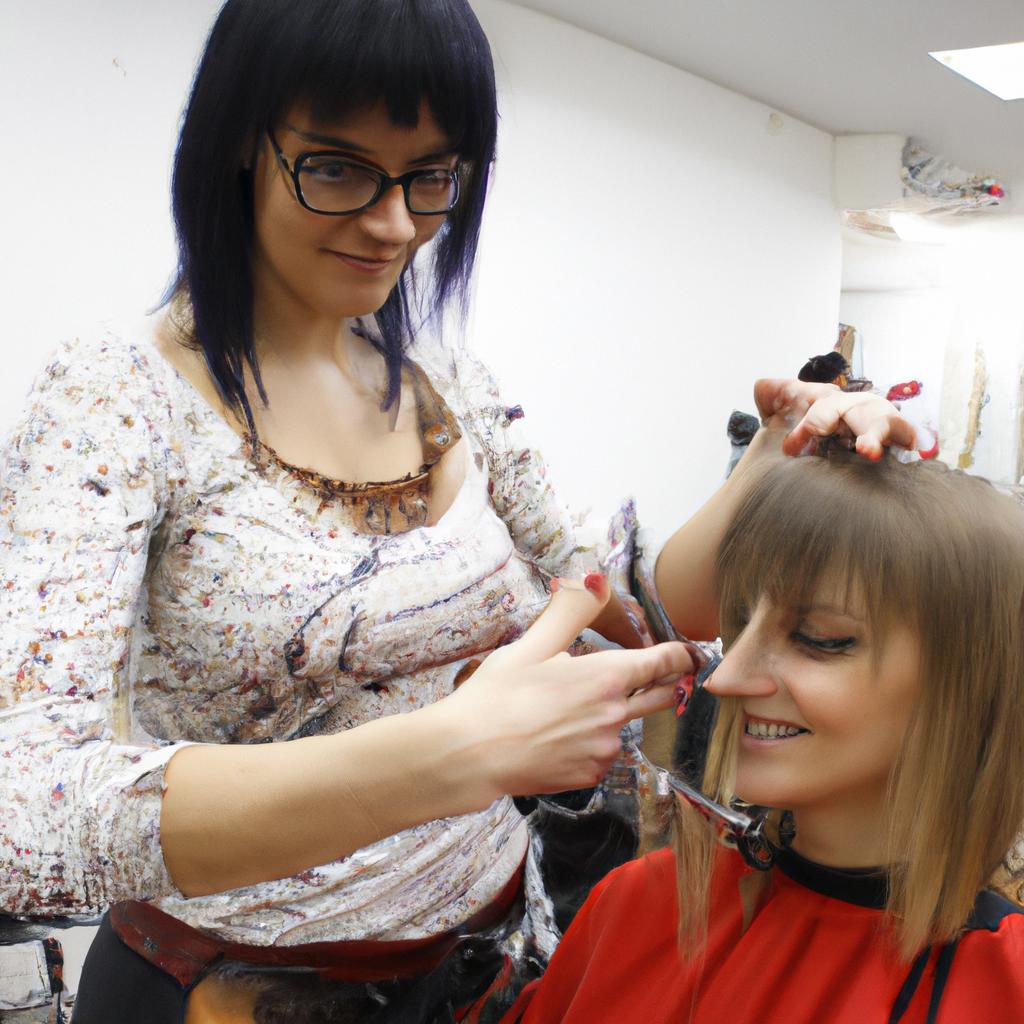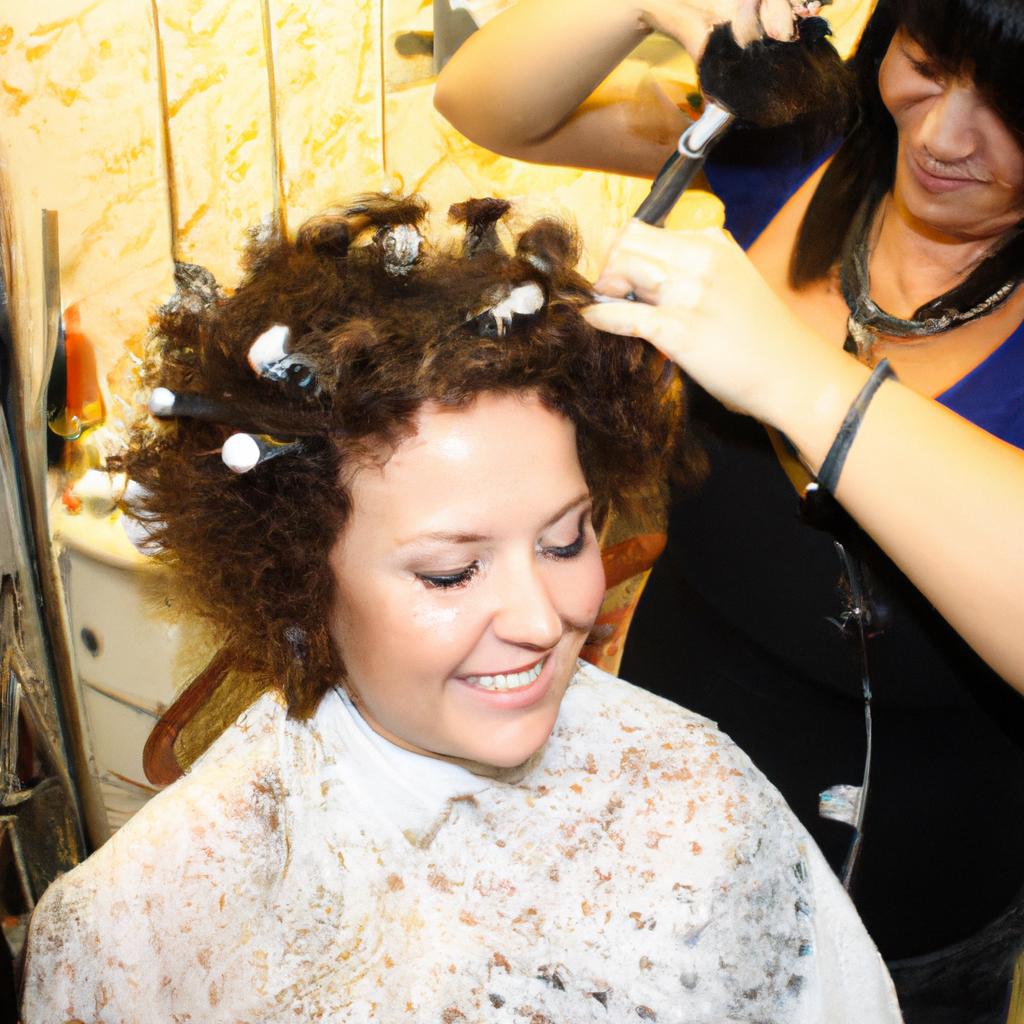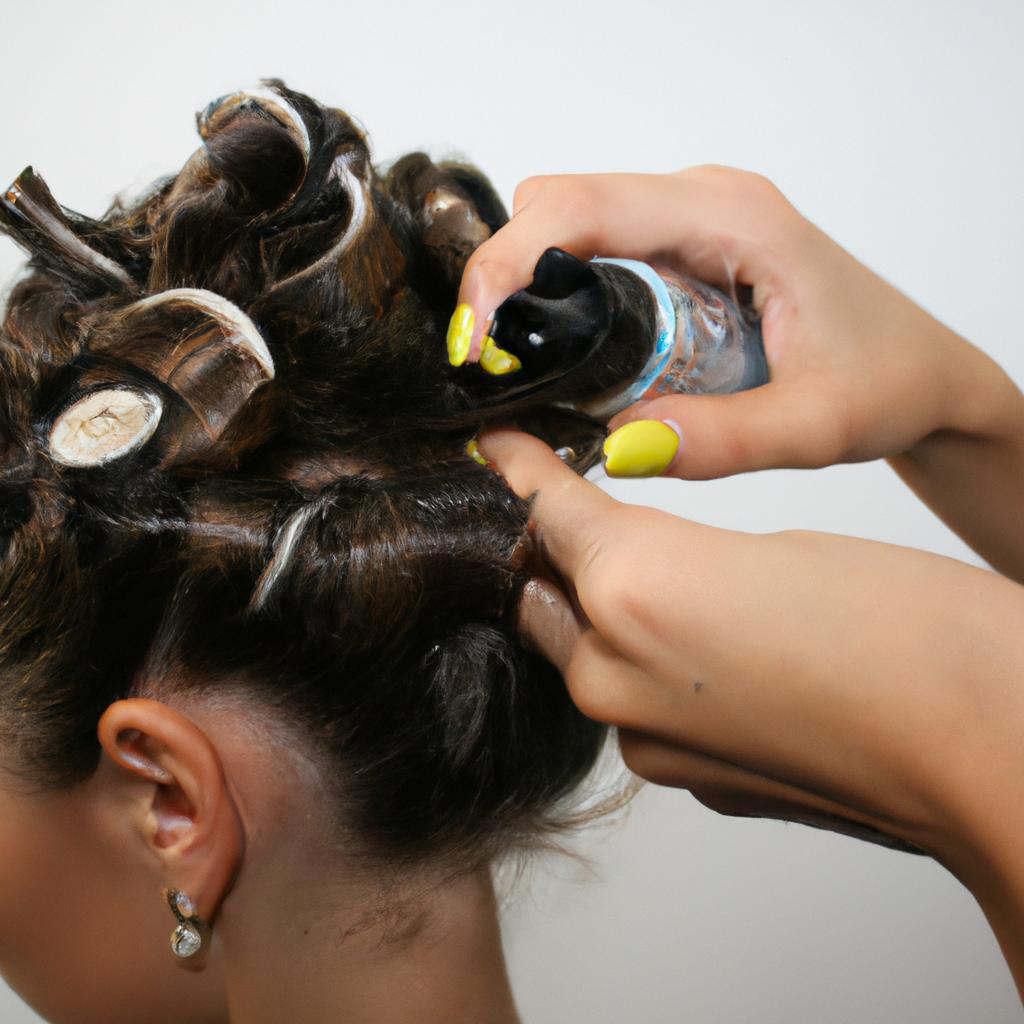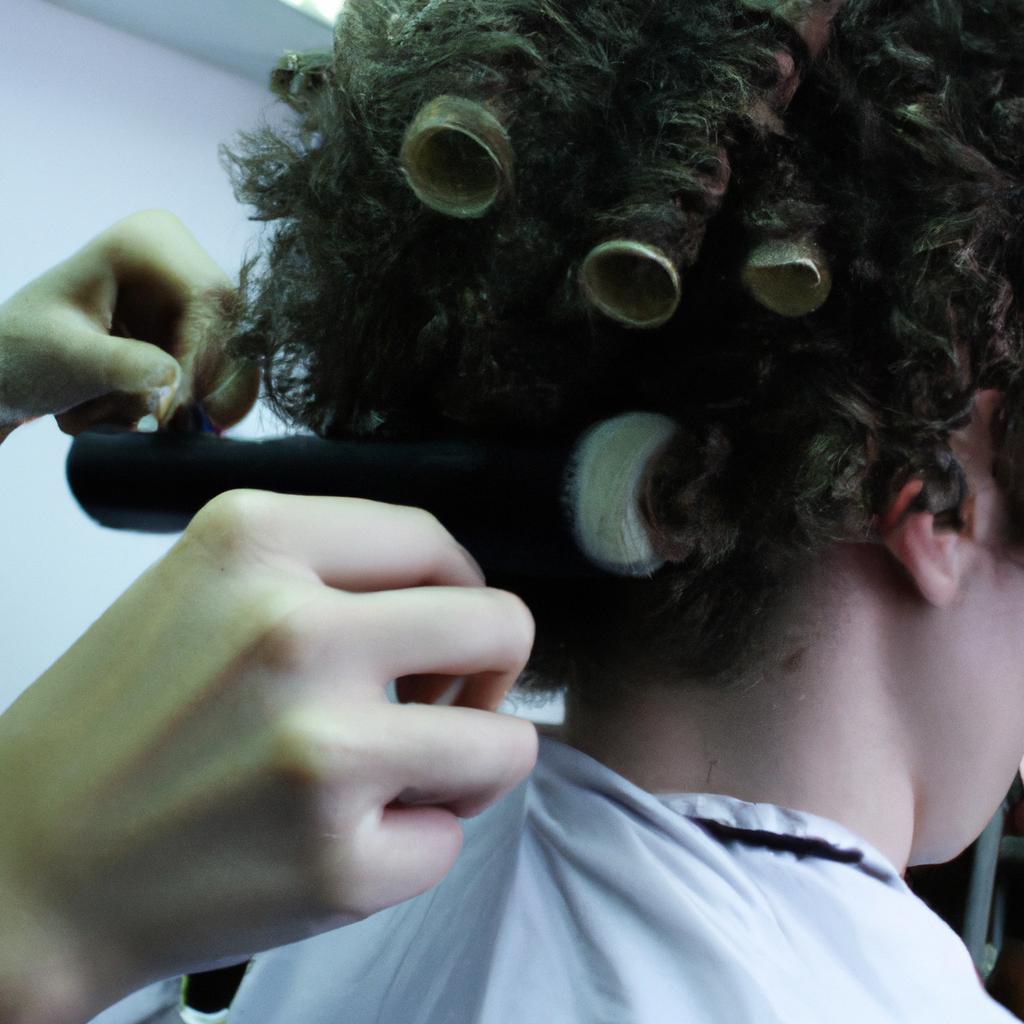The art of hair cutting is an essential skill for any professional hairdresser operating within the context of a hairdressing salon and perm. Understanding various hair cutting techniques not only allows stylists to create unique and personalized looks for their clients, but it also ensures that they can effectively deliver on client expectations. For instance, imagine a scenario where a client walks into a salon with long, unmanageable locks and desires a shorter hairstyle that complements their facial features. Without knowledge of appropriate cutting techniques, the stylist may struggle to achieve the desired outcome or even risk creating an unsatisfactory result.
In this article, we will explore different hair cutting techniques specifically tailored towards professionals in the field of hairdressing salons and perms. By delving into these techniques, we aim to equip hairstylists with valuable tools and insights that will enhance their craft. This guide will cover a diverse range of topics including precision cutting methods, layering techniques, texturizing approaches, and recommendations for specific hairstyles based on individual preferences and face shapes. Additionally, we will discuss how these techniques can be adapted to suit different hair types and textures while considering factors such as maintenance requirements and product suitability.
Types of Cuts
To fully comprehend the art of hair cutting, it is crucial to familiarize oneself with the various types of cuts. Understanding these techniques allows hairdressers to cater to their clients’ unique preferences and enhance their overall appearance. One example that highlights the significance of selecting the appropriate cut can be seen in a hypothetical scenario where a client desires a drastic change from long locks to a short pixie cut. By utilizing specific cutting methods, such as layering or texturizing, hairdressers can achieve a desired outcome while maintaining the natural flow and balance of the client’s hair.
Exploring different types of cuts reveals an array of possibilities for both hairstylists and clients alike. It provides an opportunity to experiment with styles ranging from classic looks to trendy alternatives that reflect individual personalities. To evoke excitement and curiosity within the audience, consider this bullet point list showcasing some popular haircut options:
- Bob: A versatile style that suits various face shapes and can be customized with layers or bangs.
- Pixie: An edgy and low-maintenance cut that accentuates facial features.
- Shag: A textured look characterized by choppy layers, offering volume and movement.
- Fade: A men’s hairstyle involving tapered sides and back, gradually blending into longer hair on top.
In addition to bullet points, incorporating visual elements like tables can further engage readers. The table below demonstrates how different cuts complement certain facial structures:
| Facial Shape | Suitable Haircut |
|---|---|
| Oval | Any |
| Round | Layers |
| Square | Soft Bangs |
| Heart/Inverted | Long Bob |
By considering factors such as face shape and personal style, hairdressers can recommend appropriate cuts that enhance their clients’ natural beauty.
Transitioning into the subsequent section about “Tools and Equipment,” it is essential for stylists to not only have knowledge of various cutting techniques but also be equipped with the appropriate tools. These tools enable them to execute cuts effectively and ensure client satisfaction.
Tools and Equipment
Transitioning from the previous section on “Types of Cuts,” we now delve into the essential tools and equipment that hairdressers utilize to achieve various cutting techniques in a hairdressing salon. Understanding these tools’ function is crucial for hairstylists who want to excel in their craft and deliver optimal results.
For instance, let’s consider a case where a client desires a layered haircut with textured ends. To accomplish this, the hairdresser would employ specific techniques such as point-cutting or slide cutting. Point-cutting involves using scissors to snip vertically into the hair strand, creating texture and softness. On the other hand, slide cutting entails holding the scissors at an angle while sliding them down the length of the hair, resulting in seamless layers.
To execute these techniques effectively, here are some key tools and equipment commonly used by hairdressers:
- Scissors: The primary tool for cutting hair; they come in various sizes and designs, including straight-edge shears, thinning shears (used for texturizing), and serrated edge shears.
- Clippers: Electric devices typically employed for shorter hairstyles or precise fades.
- Razors: Used for adding texture or removing bulk from certain sections of the hair.
- Combs: Essential for sectioning and parting the hair during different cutting processes.
These tools not only facilitate precision but also play a vital role in enhancing clients’ overall experience within the salon environment. By utilizing high-quality implements alongside expert technique, skilled stylists can create stunning transformations that leave their clients feeling confident and satisfied.
Moving forward to our next topic on “Sectioning Techniques,” we explore how proper division of hair plays a fundamental role in achieving desired cuts and styles. Understanding different methods of partitioning allows professionals to work systematically through each section, ensuring accurate execution throughout every step of the styling process.
Sectioning Techniques
By mastering efficient hair cutting techniques, hairdressers can provide clients with exceptional results while ensuring a seamless experience at the salon.
Case Study: Imagine a scenario where a client walks into a hairdressing salon seeking a perm. The skilled hairstylist begins by assessing the client’s hair type and desired outcome. They then proceed to utilize specific cutting techniques tailored to achieve optimal results within the context of perming.
To enhance your understanding of effective hair cutting techniques, consider the following bullet points:
- Precision Cutting Technique: This technique involves carefully measuring and analyzing each section before making any cuts. It ensures accuracy and consistency throughout the haircutting process.
- Texturizing Technique: Utilized to add texture and movement, this technique involves strategically removing bulk from certain sections or layers of the hair using specialized texturizing shears.
- Graduation Technique: A versatile method used to create different lengths within one hairstyle, graduation involves cutting shorter layers underneath longer ones, resulting in a graduated effect.
- Blending Technique: This technique focuses on seamlessly blending transitions between various sections or layers of hair, creating an effortless flow from one length to another.
Consider the table below as a visual representation of how these techniques can contribute to achieving diverse hairstyles:
| Technique | Purpose | Tools Required |
|---|---|---|
| Precision Cutting | Ensures accurate and consistent cuts | Sharp scissors |
| Texturizing | Adds texture and movement | Texturizing shears |
| Graduation | Creates different lengths | Scissors, comb |
| Blending | Seamlessly blends transitions | Scissors |
By incorporating these innovative techniques, hairdressers can elevate their skill set and provide clients with hairstyles that not only meet their expectations but also exceed them. This section has explored the importance of mastering various cutting techniques in the context of a hairdressing salon and perm.
With a solid understanding of tools, equipment, and essential cutting techniques established, let’s now delve into another vital aspect of hairdressing – layering techniques.
Layering Techniques
In the world of hairdressing, achieving the perfect texture is essential to creating stunning hairstyles that stand out. Whether it’s adding volume and movement or reducing bulkiness, texturizing techniques play a crucial role in transforming ordinary hair into extraordinary styles. Let’s delve into some popular texturizing techniques used by professional hairdressers.
One example of a widely employed texturizing technique is point cutting. By strategically cutting individual strands at different lengths using scissors, this method creates textured ends, giving the hairstyle a more natural and organic look. For instance, imagine a client with long straight hair wanting to add dimension and softness to their locks. A skilled hairdresser would utilize point cutting to create layers and remove any blunt lines, resulting in a cascading effect that enhances both body and movement.
To better understand the various texturizing techniques available for hairstylists, here are four key points to consider:
- Textured layers can help reduce weight and give fine hair an illusion of fullness.
- Thinning shears are often used to remove excess bulk from thick or unruly tresses without sacrificing length.
- Razor-cutting is an effective way to achieve wispy textures and shattered edges for edgier looks.
- The use of special razors or notching shears can create precise texture on specific sections while maintaining overall shape.
Additionally, we present below a table showcasing different texturizing techniques along with their primary objectives:
| Technique | Objective |
|---|---|
| Point Cutting | Creating textured ends |
| Textured Layers | Reducing weight |
| Thinning Shears | Removing excess bulk |
| Razor-Cutting | Achieving wispy textures |
By incorporating these texturizing techniques into your repertoire as a professional hairdresser, you can elevate your skills and offer clients personalized styles tailored to their preferences and hair types.
Transitioning smoothly to the subsequent section about “Graduation Techniques,” hairstylists can explore additional ways to create stunning hairstyles with precise graduations, enabling seamless transitions between lengths and enhancing overall shape.
Graduation Techniques
Building on the foundation of layering techniques, we now turn our attention to the art of creating dimension and movement in haircuts. By utilizing various layering methods, hairdressers can enhance a client’s desired style while adding volume and texture. This section will explore different layering techniques that are commonly employed by skilled hair professionals.
Example:
To better illustrate the impact of layering techniques, let us consider a hypothetical scenario involving a client named Sarah. Sarah has long, straight hair and expresses her desire for a more dynamic look with added volume. In response to her request, the hairdresser decides to incorporate layers into Sarah’s haircut using specific techniques discussed below.
The following bullet point list highlights key considerations when employing layering techniques:
- Determine the appropriate length and density of layers based on individual hair type.
- Consider facial structure and features to ensure a flattering outcome.
- Use professional-grade scissors with sharp blades for precise cutting.
- Take into account personal style preferences when designing layered hairstyles.
In addition to these considerations, it is crucial for hairdressers to understand how different layering techniques contribute to achieving desired results effectively. The table below provides an overview of three popular layering methods along with their distinctive characteristics:
| Layering Technique | Description | Best Suited For |
|---|---|---|
| Long Layers | Gradual blending of longer lengths | Clients seeking flowing hairstyles |
| Short Layers | Sharp contrasts between shorter sections | Individuals desiring edgy looks |
| Face-Framing | Layer placement around the face | Those looking for framing effect |
By incorporating such variety in their hairstyling repertoire, hairdressers can cater to diverse aesthetic preferences and offer clients personalized experiences.
Transition sentence into subsequent section about “Texturizing Techniques”:
Moving forward, we delve into the realm of texturizing techniques, which further enhance haircuts by adding depth and dimension. Through strategic manipulation of hair fibers, these techniques create texture that complements a client’s desired style seamlessly.
Texturizing Techniques
Transitioning from the previous section on Graduation Techniques, let us now explore another essential aspect of hair cutting techniques: Texturizing Techniques. These techniques play a crucial role in creating texture and movement within the hair, allowing for versatile styling options that cater to individual preferences.
To illustrate the significance of texturizing techniques, consider the case study of Sarah, who has long straight hair. She desires a style with more volume and dimension while maintaining her length. By employing various texturizing techniques such as layering and point cutting, Sarah’s stylist can achieve this desired outcome. Layering involves removing weight from specific sections of the hair by cutting shorter layers underneath longer ones. On the other hand, point cutting creates texture by selectively snipping into the ends of the hair at different angles. Through these methods, Sarah’s stylist is able to transform her flat, lifeless locks into a voluminous, textured hairstyle suited to her needs.
Texturizing techniques offer several advantages that contribute to their popularity among both hairstylists and clients alike:
- Enhanced Volume: By strategically thinning out or adding layers to the hair using texturizing scissors or razors, stylists create an illusion of increased volume. This technique is particularly beneficial for individuals with fine or thin hair.
- Improved Texture: Texturizing allows for enhanced texture within hairstyles, providing depth and interest. This technique gives flexibility when it comes to styling choices and adds visual appeal.
- Effortless Styling: Well-executed texturizing techniques make daily maintenance easier for clients by reducing bulkiness and facilitating effortless styling routines.
- Personalized Looks: With texturizing techniques at their disposal, hairstylists have greater creative freedom to customize styles according to each client’s unique features and preferences.
Indeed, texturizing techniques are indispensable tools in a hairstylist’s arsenal, enabling them to craft personalized looks tailored specifically to their clients’ desires. To further understand the impact of these techniques, let us consider a comparison between two hairstyles: one without texturizing and another with texturizing applied.
| Hairstyle Features | Without Texturizing | With Texturizing |
|---|---|---|
| Volume | Flat | Voluminous |
| Movement | Limited | Dynamic |
| Styling Options | Restricted | Versatile |
In conclusion, texturizing techniques offer hairstylists the means to transform dull, lifeless hair into vibrant styles that enhance volume, texture, and movement. By employing strategic layering and point cutting methods, stylists can achieve personalized looks that cater to each client’s unique needs and preferences. The versatility afforded by these techniques ensures effortless styling options while adding visual interest to hairstyles. Whether it be creating depth or maximizing volume, texturizing techniques are invaluable in achieving desired outcomes for clients seeking versatile and dynamic haircuts.




